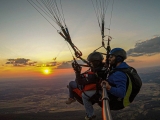
With this in mind, we’ve selected the most celebrated regions for mycology enthusiasts, aiming to share a well-kept secret with you—because mushroom foraging is the closest thing to finding a needle in a haystack.
PINARES DE SORIA (SORIA AND BURGOS)
Between Burgos and Soria, you can forage for various types of mushrooms and fungi—it’s said that over 60 edible species thrive here. Among them, the most notable are saffron milk caps and porcini, though the oyster mushroom is also a common sight.
This area has established itself as one of the best spots for foraging, thanks to its incredible diversity. If you plan to explore these pine forests, make sure to obtain the necessary permits.
SIERRAS DE FRANCIA, BÉJAR, QUILAMAS, AND EL REBOLLAR (SALAMANCA)
A mycological park spanning more than 57,000 hectares, where you’ll find a vibrant array of yellows and oranges among your mushrooms. Here, the Caesar’s mushroom, known as orange amanita or egg yolk mushroom, lives up to its reputation.
Given its mycological significance, a network of trails has been created for foragers. Specifically, there are five:
- Montemayor del Río - El Cerro
- Cepeda - Madroñal - Herguijuela de la Sierra
- Tamames - Aldeanueva de la Sierra
- Villasrubias - Peñaparda
- El Cabaco - Nava de Francia
MONTES DE VALSAÍN (SEGOVIA)
Still within Castile and León, in the province of Segovia, lies the Montes de Valsaín, nestled in the Sierra de Guadarrama. This forest, dense with pines and oaks, is the perfect ground for harvesting species like Boletus edulis and saffron milk caps.

Here, you’ll also need a foraging permit, issued by the National Parks Autonomous Agency.
VALLE DE BAZTÁN (NAVARRA)
This could be the ideal setting to fill your basket with mushrooms—why? It’s a region rich in humidity, fostering the growth of diverse mushroom species.
Highlights include the Caesar’s mushroom, St. George’s mushroom, and poplar mushrooms, though the most peculiar are the black trumpets. As elsewhere, proper permits are required here.
SIERRA DE ARACENA AND PICOS DE AROCHE (HUELVA)
While Huelva is famed for its beaches, inland you’ll discover the Sierra de Aracena and Picos de Aroche, two magical enclaves for mushroom hunting.
Among cork oaks and chestnut trees, you’ll spot a variety of fungi, including field mushrooms, yellow trumpets, chanterelles, and saffron milk caps.

Other Popular Foraging Destinations
Serranía de Cuenca
The province of Cuenca is a treasure trove for mycology lovers, boasting up to 2,000 different species of fungi and mushrooms. The most well-known varieties include russulas, tricholomas, porcini, and amanitas.Tarragona
No list would be complete without Catalonia, home to one of the most delicious and sought-after mushrooms in the region: bolets or rovellons.
In Tarragona, you’ll find several mycological routes where you can forage for these prized mushrooms, alongside species like black trumpets, waxcaps, and chanterelles. Gather all the ingredients beforehand—you’ll want to cook a traditional Catalan rovellons dish that’ll leave your guests speechless.
Now that you know where to go foraging, how to prepare, and that mythical creatures won’t be joining you, planning your next autumn escape is easier than ever. We’d even argue that mushroom foraging is the latest trend among the most












